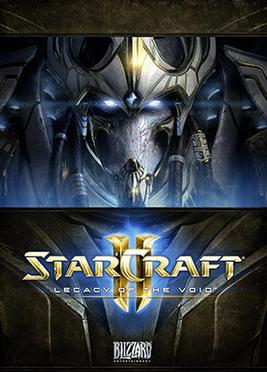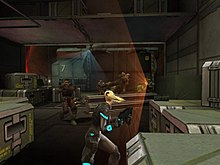
Blizzard Entertainment, Inc. is an American video game developer and publisher based in Irvine, California, and a subsidiary of Activision Blizzard. Originally founded in 1991, the company is best known for producing the highly influential massively multiplayer online role-playing game World of Warcraft (2004), as well as the multi-million selling video game franchises Diablo,StarCraft and Overwatch. The company also operates Battle.net, an online gaming service.

StarCraft is a real-time strategy video game developed and published by Blizzard Entertainment for Microsoft Windows. The first installment of the video game series of the same name, it was released in 1998. A Classic Mac OS version was released in 1999, and a Nintendo 64 port co-developed with Mass Media and published by Nintendo was released in 2000.

The Zerg are a fictional race of insectoid aliens obsessed with assimilating other races into their swarm in pursuit of genetic perfection, and the overriding antagonists for much of the StarCraft franchise. Unlike the fictional universe's other primary races, the Protoss and Terrans, the Zerg lack technological inclination. Instead, they "force-evolve" genetic traits by directed mutation in order to match such technology. Operating as a hive mind-linked "chain of command", the Zerg strive for "genetic perfection" by assimilating the unique genetic code of advanced species deemed "worthy" into their own gene pool, creating numerous variations of specialized strains of Zerg gifted with unique adaptations. Despite being notoriously cunning and ruthlessly efficient, the majority of Zerg species have low intelligence, becoming mindless beasts if not connected to a "hive-cluster" or a "command entity".
bnetd is a communication app that enables users of the online game StarCraft released on March 31, 1998 to connect and chat together. A bnetd clone was released on April 28, 1998 under the name StarHack and provided near-complete emulation of the original online multiplayer gaming service network. This was accomplished through reverse engineering of the corporate Blizzard Entertainment's Battle.net.

StarCraft: Brood War is the expansion pack for the military science fiction real-time strategy video game StarCraft. Released in December 1998 for Microsoft Windows and June 1999 for Mac OS, it was co-developed by Saffire and Blizzard Entertainment. The expansion pack introduces new campaigns, map tilesets, music, extra units for each race, and upgrade advancements. The campaigns continue the story from where the original StarCraft ended, with the sequel, StarCraft II: Wings of Liberty, continuing from the conclusion of Brood War. The expansion was released first in the United States on December 18, 1998.

Sarah Louise Kerrigan, the self-styled Queen of Blades, is a character in Blizzard Entertainment's StarCraft franchise. She was created by Chris Metzen and James Phinney, and her original appearance was designed by Metzen. Sarah Kerrigan is voiced by Glynnis Talken Campbell in StarCraft and Brood War, Tricia Helfer in StarCraft II: Wings of Liberty, Heart of the Swarm and Legacy of the Void, and Vanessa Marshall in Heroes of the Storm.

James Eugene Raynor is a major protagonist in Blizzard Entertainment's science fiction StarCraft series. Raynor is a predominant character in the science fiction real-time strategy video games StarCraft and Brood War and is a player character in StarCraft II: Wings of Liberty. He also appears as a playable character in the crossover multiplayer online battle arena game Heroes of the Storm. Outside video games, Raynor appears in the novels Liberty's Crusade and Queen of Blades, while his backstory is explored in the novels Heaven's Devils and Devil's Due. Robert Clotworthy voices the character in all video game appearances.

Metal Arms: Glitch in the System is a third-person shooter action-adventure video game, developed by American team Swingin' Ape Studios, published by Vivendi Universal Games and their subsidiary Sierra Entertainment and released in 2003. The game follows a robot named Glitch as he joins forces with the Droids in their fight against General Corrosive and his Milbots.

nStigate Games was an American video game developer based in Novato, California.

BlizzCon is an annual gaming convention held by Blizzard Entertainment to promote its major franchises including Warcraft, StarCraft, Diablo, Hearthstone, Heroes of the Storm, and Overwatch.
Major and recurring characters from the military science fiction series StarCraft are listed below, organised by respective species and most commonly affiliated faction within the fictional universe. The story of the StarCraft series revolves around interstellar affairs in a distant sector of the galaxy, where three species are vying for supremacy: the Terrans, a highly factionalised future version of humanity; the Protoss, a theocratic race of vast psionic ability; and the Zerg, an insectoid species commanded by a hive mind persona. The latter two of these species were genetically engineered by the Xel'Naga, a fourth species believed extinct. The series was begun with Blizzard Entertainment's 1998 video game StarCraft, and has been expanded with sequels Insurrection, Retribution, Brood War, Ghost, Wings of Liberty, Heart of the Swarm, and Legacy of the Void. The franchise has been further extended with a series of novels, graphic novels, and other works.
StarCraft is a military science fiction media franchise created by Chris Metzen and James Phinney and owned by Blizzard Entertainment. The series, set in the beginning of the 26th century, centers on a galactic struggle for dominance among four species—the adaptable and mobile Terrans, the ever-evolving insectoid Zerg, the powerful and enigmatic Protoss, and the godlike Xel'Naga creator race—in a distant part of the Milky Way galaxy known as the Koprulu Sector. The series debuted with the video game StarCraft in 1998. It has grown to include a number of other games as well as eight novelizations, two Amazing Stories articles, a board game and other licensed merchandise, such as collectible statues and toys.

StarCraft II: Wings of Liberty is a science fiction real-time strategy video game developed and published by Blizzard Entertainment. It was released worldwide in July 2010 for Microsoft Windows and Mac OS X. A sequel to the 1998 video game StarCraft and the Brood War expansion pack, the game is best known as the original installment of StarCraft II which was later followed by a number of expansion packs. Wings of Liberty has been free-to-play since November 2017.

Battle.net is an Internet-based online game, social networking service, digital distribution, and digital rights management platform developed by Blizzard Entertainment. The service was launched on December 31, 1996, followed a few days later with the release of Blizzard's action-role-playing video game Diablo on January 3, 1997. Battle.net was officially renamed to "Blizzard Battle.net" in August 2017, with the change being reverted in January 2021.

StarCraft II: Heart of the Swarm is an expansion pack to the military science fiction real-time strategy game StarCraft II: Wings of Liberty, and the second part of the StarCraft II trilogy developed by Blizzard Entertainment, with the final part being Legacy of the Void. The game was released on March 12, 2013.

StarCraft II: Legacy of the Void is a standalone expansion pack to the military science fiction real-time strategy game StarCraft II: Wings of Liberty, and the third and final part of the StarCraft II trilogy developed by Blizzard Entertainment. The game was released on November 10, 2015.
StarCraft II is a real-time strategy video game created by Blizzard Entertainment, first released in 2010. A sequel to the successful StarCraft, released in 1998, it is set in a militaristic far future. The narrative centers on a galactic struggle for dominance among various races.

StarCraft II: Nova Covert Ops is a downloadable content (DLC) single-player mission pack for the military science fiction real-time strategy game series StarCraft II. Consisting of nine missions, it was released over the course of three installments as DLC, with three missions in each separably purchasable pack. The first mission pack was released March 29, 2016, the second mission pack released on August 2, 2016 and the final mission pack was released on November 22, 2016.

















